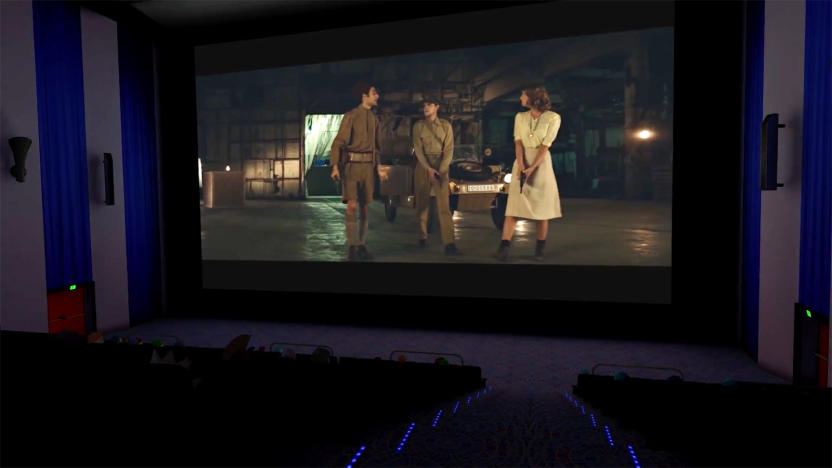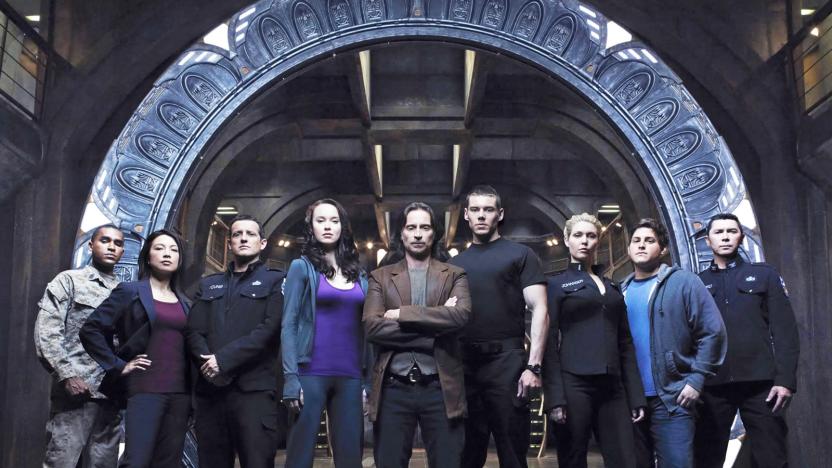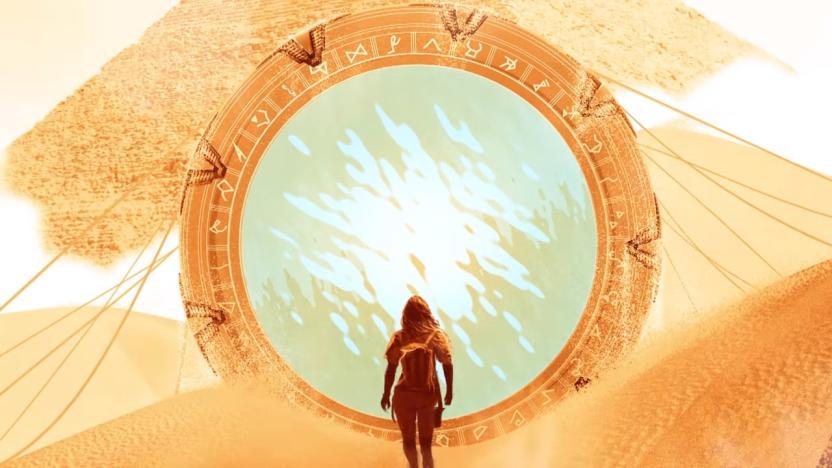Stargate
Latest

Amazon is reportedly negotiating to buy MGM
Amazon is reportedly considering a $9 billion acquisition that would make it the owner of franchises like James Bond, Stargate and Robocop.

The 'Stargate' streaming service is closing shop and moving to YouTube
After less than two years in operation, Stargate Command, the sci-fi series' official streaming service and fan hub, is shutting down at the end of the year. It's not a total loss though; original shows like Dialing Home and Recon will be available for free on YouTube in 2020. Stargate aficionados are sure to be disappointed by the news, but this seemed like a weird pull from the beginning. Even a dedicated Star Trek streaming service sounds dubious, despite Star Trek having a far broader audience.

Watch 'Stargate Origins' for free in VR starting March 8th
Want to (legally) watch Stargate Origins for free? If you splurged on a virtual reality headset, you can. MGM and Bigscreen have teamed up to screen the first two episodes of the sci-fi TV show for free in VR between March 8th at 6PM Eastern and March 11th at 3AM Eastern. The virtual 'showtimes' will start every 30 minutes and will be available in the US, the UK, Canada, Australia, New Zealand and Germany. Naturally, Bigscreen is hoping you'll sign up for Stargate Command to watch the rest of the series when all is said and done.

'Stargate: Origins' debut brings the 1994 flick along for free
As promised, MGM's Stargate Command service has launched the first three episodes of Stargate: Origins exclusively for its streaming customers. The service is making a pitch similar to, but not exactly like the one attempted by CBS' controversial All Access setup with Star Trek: Discovery, charging a one-time $20 fee for access to "the ultimate Stargate library including SG-1, Atlantis, Universe, and all 3 movies." Sure, they used to be available on Netflix in the US, but now their owner is trying to squeeze a bit more value out of the franchise.

‘Stargate: Origins’ will make its streaming debut on February 15th
Stargate: Origins, the digital-only prequel show, will make its debut on February 15th, according to a teaser that was released today. It will be available exclusively on Stargate Command, a dedicated platform where fans can interact and watch all the movies and TV episodes. The price appears to be a one-time $20 fee.

Unlimited 'Stargate' streaming will cost you $20
MGM Studios announced a new web-based entry into its popular Stargate franchise, Stargate Origins, this past July at San Diego Comic Con. In order to see the prequel series, though, you'll have to subscribe to a Stargate-only streaming service, too. Called Stargate Command, the new portal for all things Stargate is now online and ready for subscribers.

'Stargate' revival will launch a new MGM streaming service
At Comic-Con, MGM celebrated the 20th anniversary of Stargate by announcing a new TV show in the series: Stargate Origins. Other than a teaser trailer and news that it will serve as a prequel there isn't much info about the show, but we know that to watch it, fans will be asked to subscribe to a new streaming service.

The Game Archaeologist: Six more MMOs that never made it to launch
It's always possible to be surprised with reveals of older MMOs, even after years of writing this column. For example, I had never heard that Valve was initially working on an MMO called Prospero in the late '90s before we posted on it a couple of weeks ago. It's crazy to me that parts of what could have been a groundbreaking online title were then repurposed for Half-Life and Portal. It's not necessarily bad how things turned out, mind you, but I do get lost wondering what might have been. From time to time here on The Game Archaeologist, I like to turn our attention to MMOs-that-never-were: titles that died before launch thanks to funding shortfalls, studio collapses, or corporate bungling. We've covered titles like Wish, Ultima X, and Middle-earth Online, but today I want to catch up on several titles that have been haunting my list for a while now. So strap in as you get a six-pack of MMOs that were never released!

EVE Evolved: Stepping through the EVE Gate
Though EVE Online is often lauded for its rich decade-long player history full of wars and complex political dealings, the NPC storyline and New Eden's ancient backstory have always held my fascination. I started playing in early 2004 after reading dozens of fiction chronicles and mock scientific articles on the EVE website that painted the picture of a real living universe where incredible things could happen. Sure enough, my first years of play were punctuated with compelling live events and storyline arcs like the Crielere research project that led to the development of cloaking devices, the theft of a Federation Navy titan by Serpentis pirates, and the Blood Raiders taking over Delve. CCP has frequently stated that its goal with EVE is to create the ultimate sci-fi simulator, and the core of a compelling sci-fi setting is a living universe that grows and changes. The best sci-fi TV shows are those with a constant cycle of revealing compelling mysteries and then solving them and of encountering escalating challenges to be overcome. EVE has done this extremely well a few times in its life, such as with the release of wormholes or when the Sansha incursions events were kicking off, and each time the concurrent player numbers have spiked. Guild Wars 2 has shown the power of an evolving living storyline to get people into the game and keep them actively playing in the long term, something that should be the norm for MMOs and that EVE Online could take much greater advantage of. In this edition of EVE Evolved, I look at some of the big NPC mysteries revealed in EVE Online's decade-long history and ask why they were abandoned and where they could go now.

EVE Evolved: Lowsec isn't impenetrable
When EVE Online was created, one of its core design philosophies was the idea of risk vs. reward -- that higher-value activities should expose the player to greater risk of loss. This rule naturally follows from how the world of business and competition works in real life, and I think it will always arise organically from sandbox MMOs with limited resources. If something's risk-free and easy to do, you can bet there are countless other people already doing it and squeezing the profit margins. This idea was also built into EVE at a fundamental level, with the galaxy split into police-protected high-security systems, the pirate-infested low-security borders between nations, and the chaotic uncolonised wilderness of nullsec. The steep step up in risk when transitioning from high- to low-security space has always been a major point of contention with gamers, as those who don't know any better often charge straight into deep space to their deaths. The story of the newbie working his way up to get his first cruiser or battlecruiser and then losing it to pirates is repeated so often on forums and in the comments sections of articles that it's almost become a cliche. While the idea that pirates wait around every corner lingers on, this impenetrable barrier hiding all the best content from new players no longer really exists. Through the addition of wormholes and the changes made in Rubicon, no star system is now off limits to a pilot with just a few months of skill training under his belt. In this week's EVE Evolved, I look at what you can do to safely travel and operate in EVE's dangerous areas, why the barrier into low-security space needs to remain low for new players, and how CCP has expanded the EVE universe through the introduction of riskier areas of space.

EVE Evolved: Grid-Fu and bending space
In last week's article, I described how EVE Online maintains the illusion of full-scale solar systems by dynamically creating small pockets of high-detail space called grids. It's within these discrete bubbles that everything we do in space takes place, from mining asteroids to running missions or shooting at other players. The system is designed to split up space into manageable chunks to reduce server load while still maintaining persistent 3-D space that appears to span the entire scale of a solar system. Grids have been in EVE since it was first created, but over the years people have noticed a few odd things about how the system works. Flying about 250km-400km away from a stargate causes your ship to disappear from that grid and pop into a newly created adjacent one, for example, but this doesn't always happen. Bizarre occurrences such as abnormally shaped grids and ships mysteriously disappearing and re-appearing on the same grid were always thought to be freak accidents or unintended bugs until an interesting document emerged in 2009. Titled Grid-Fu: A Practical Manual, the 18-page PDF described the process of bending and manipulating space for a tactical advantage. In this week's EVE Evolved, I look at the various ways that players have manipulated space to their advantage.

EVE Evolved: Colonising deep space
If you were watching the news coming out of this year's EVE Online Fanfest, you no doubt heard Senior Producer Andie Nordgren's incredibly ambitious five year vision. The past few expansions have been mostly filled with bug fixes and improvements to existing gameplay, but the goal is now to begin delivering an epic vision of deep space exploration, colonisation, and PvP raids on enemy infrastructure. The five year roadmap toward this goal includes the addition of player-built stargates and completely uncharted solar systems to locate, explore and build an empire in. If the very idea of that doesn't make shivers go down your spine, something may be wrong with your central nervous system. CCP has opened new space before with the addition of the drone regions in nullsec and some new lowsec systems for faction warfare, but it wasn't until 2009's Apocrypha expansion that we saw a true exploration and long-term colonisation effort get underway. I think the intoxicating draw of wormhole exploration was primarily due to the fact that the new systems were hidden and the information on them wasn't public. Just adding new solar systems to the existing stargate network wouldn't have had the same effect. Nordgren's vision may take up to 10 expansions to fully realise, but what kinds of features will we need in those expansions to recreate true exploration and deep space colonisation? In this week's EVE Evolved, I look at some of the challenges CCP will have to overcome to make deep space colonisation a reality and what small steps could be taken in each expansion to get us there.

EVE Evolved: First impressions of Odyssey
The Odyssey expansion has been live for a couple of days now, but it's already starting to have a massive impact on EVE Online. Traffic through low-security space has increased significantly for the first time in years thanks to explorers hunting data and relic sites, and some players are even hunting asteroid belt NPCs in lowsec for the new security tags. New wars have erupted in nullsec following the redistribution of moon wealth, mining has become a more valuable profession, and the rebalanced battleships feel powerful again. Unfortunately, Odyssey has seen its fair share of problems too. The new jump effect looks spectacular the first few times you see it, but long-term play is reportedly causing motion sickness in some players. Some players have also been objecting to the ice mining changes, and the revamped radial UI menu hasn't done much to fix the game's usability problems. Explorers in low-security space and nullsec are reporting incomes in the billions of ISK per day range thanks to the scan probe changes and new hacking minigame, but not everyone is happy with the new loot-scattering mechanic. In this week's EVE Evolved, I look at the early impact of Odyssey on the EVE Online universe and discover the secrets behind collecting all the valuable loot when hacking.

EVE Fanfest 2013 final day: Trailers, EVE's TV show, and a vision for the future
We usually don't expect to see much from the final day of the EVE Fanfest, but for this year's tenth anniversary celebration, CCP isn't doing anything by half measures. The first two days of the event had a strong focus on DUST 514 and EVE Online, delving into the specific details of DUST's upcoming Uprising update and EVE's Odyssey expansion. I went into the convention centre today expecting a nice slow wind down with the usual CCP Presents keynote looking at the state of the company, but I left with several huge reveals that seemed to come out of nowhere. Not only did we find out that EVE Online is finally getting a collector's edition box full of goodies, but CCP revealed that a new EVE comic book and lore compendium are both on the way. As if that weren't enough, there's also an EVE TV series in the works based on player-submitted stories of true events inside the EVE universe. I couldn't help escaping the feeling, though, that this year's CCP Presents talk was more than a little marketing-oriented. As one of the press put it to me after the talk, it felt at times like watching an infomercial. On the plus side, we did get to see more of CCP's future vision for the EVE universe and an amazing new trailer showing the game's core storyline. Read on to check out the incredible EVE Universe Origins trailer and my summary of the final day of Fanfest 2013.

EVE Fanfest 2013 day two: World of Darkness, Odyssey, and EVE Virtual Reality with the Oculus Rift
EVE Online's tenth anniversary Fanfest promised to be its biggest yet, with over 1,400 players packed into Iceland's Harpa convention centre to find out the latest on EVE Online, DUST 514, and World of Darkness. The first day focused mainly on DUST and its link with the EVE universe, but today the focus largely switched back to internet spaceships. There were plenty of roundtable discussions, and the CSM and Alliance panels were as awesome as ever, but it was the EVE Keynote that really blew the crowd away. The day got off to a good start with the highly anticipated World of Darkness talk. Most fans were probably expecting to see more airy game design ideas and another shiny trailer, but this year CCP just came out and put all its cards on the table. We saw that the game is still firmly in pre-production, with much of the previous work going into developing the engine and cool content creation tools and shaders. While I was initially disappointed at the lack of gameplay progress or shiny cinematics, I found this approach of being open and direct with fans very refreshing. As I told WoD art director Thomas Holt, honest beats shiny every time. Read on for a full run-down of the EVE reveals from the second day of EVE's tenth anniversary Fanfest, including in-depth details of the Odyssey expansion's features.

EVE Evolved: How would you build a sandbox?
Themepark MMOs and single-player games have long dominated the gaming landscape, a trend that currently seems to be giving way to a resurgence of sandbox titles. Though games like Fallout and the Elder Scrolls series have always championed sandbox gameplay, very few publishers seem willing to throw their weight behind open-world sci-fi games. Space simulator Elite was arguably the first open-world game in 1984, and EVE Online is currently closing in on a decade of runaway success, yet the gaming public's obsession with space exploration has remained relatively unsatisfied for years. Crowdsourced funding now allows gamers to cut the publishers out of the picture and fund game development directly. Space sandbox game Star Citizen is due to close up its crowdfunding campaign on Kickstarter tomorrow night, adding over $1.6 million US to its privately crowdfunded $2.7 million. The creator of Elite has also launched his own campaign to fund a sequel, and even the practically vapourware sandbox MMO Infinity has announced plans to launch a campaign. While not all of these games will be MMOs, it may not be long before EVE Online has some serious competition. EVE can't really change much of its fundamental gameplay, but these new games are being built from scratch and can change all the rules. If you were making a new sandbox MMO from the ground up and could change anything at all, what would you do? In this week's EVE Evolved, I consider how I'd build a sandbox MMO from the ground up, what I'd take from EVE Online, and what I would change.

EVE Evolved: Player justice in Retribution
This week CCP released a new devblog on upcoming piracy and PvP changes heading to EVE Online with this winter's Retribution expansion. In addition to new ships and an as-yet unrevealed bounty hunter revamp, Retribution completely redesigns the Crimewatch system that decides whom you can legally shoot and stops players from docking or jumping out of the system in the middle of combat. EVE's aggression mechanics are notoriously complicated and buggy, but Retribution aims to simplify the system and put players in the driving seat of criminal justice. The new Crimewatch system not only gets rid of old, undocumented code that was written when dinosaurs roamed the earth but also has far-reaching consequences for pirates, people engaging in PvE and the upcoming bounty hunting revamp. Pirates will now be able to escape into high-security space without police intervention, loot thieves will be subjected to mob justice, nullsec ratters won't be as safe as they think, and neutral remote repairing will be a thing of the past. In this week's EVE Evolved, I delve into Crimewatch 2.0 and how the Retribution expansion will change the game for pirates, ratters, and people engaging in PvP across New Eden.

Insert Coin: Luminode dimmer switch runs on a mesh network, learns to light up our lives (video)
In Insert Coin, we look at an exciting new tech project that requires funding before it can hit production. If you'd like to pitch a project, please send us a tip with "Insert Coin" as the subject line. Just a simple light switch, you say? Look closer. Think Automatic's Luminode dimmer switch hides both a processor and a mesh network connection that lets every switch in the home coordinate with each other. A multi-tap system makes it possible to link multiple lights together without extra wiring or complex programming, but that's just the start: it's possible to create "scenes" of predefined lighting levels and, with a USB adapter, hook up to home automation systems (including Think Automatic's own) that can learn usage habits, track energy consumption or simply let us control the array with our smartphones. The platform uses raw XML to communicate and already talks to GE, Insteon and Stargate hardware -- all without requiring a huge grid of buttons or displays. Development of the Luminode is very nearly done after six-plus years of work in Seattle. The hardware is fundamentally ready and just needs the Kickstarter project to finish its FCC and UL testing along with the obligatory mass production. The hope is to start delivering switches in January as well as integrate more closely with non-lighting elements in the future. Pledge levels are dictated almost exclusively by volume: $130 is what it takes to get a basic two-switch kit, $260 will add the USB adapter along with an extra switch, and successive levels scale all the way up to a 50-switch, $3,000 kit for large homes. Think Automatic has a relatively low $35,000 threshold to meet its Kickstarter funding, but it only has 13 days left to go. If you like the idea of advanced lighting that doesn't require an advanced appreciation of the user manual to understand, now's a good time to click the source link and make it happen.

Stargate Worlds is not resting in peace as new lawsuit emerges
Travel back two years to when Cheyenne Mountain Entertainment was filing for bankruptcy and (unsuccessfully) attempting to sever ties with Gary Whiting, Chairman and CEO of the company. Stargate fans watched as their hopes for an MMO were dashed. Fast forward to present day, when Stargate Worlds appears back in the news. Unfortunately for fans, it has nothing to do with offering a sliver of hope that the game itself might also revive; instead, more lawsuits are being filed against Whiting and other Cheyenne employees. The newest lawsuit filed in Arizona includes 17 plaintiffs who accuse Whiting of misleading investors in various ways to obtain their cash. Some of the allegations leveled at Whiting include "negligent misrepresentation, breach of fiduciary duty, common-law fraud and securities fraud"; he's also accused of issuing loans to himself from the company's funds -- money that may still be in Whiting's possession, according to Cheyenne Mountain's court-appointed receiver, Keith Bierman of Phoenix-based MCA Financial Group.

Neonode zForce uses infrared LEDs to measure pressure, replace capacitive touch (hands-on)
Smartphone fanatics may recall the Neonode N2 -- a rather unique recall-plagued feature phone that ultimately resulted in the demise of the company's handset arm. Neonode is still a major player in the portable device market, but may be more familiar to OEMs that employ its infrared LED-based touch technology, rather than consumers that utilize it in e-readers, with tablets soon joining the mix. zForce offers several advantages over its capacitive-based counterparts -- it's incredibly responsive and accurate, and can now measure the intensity (or pressure) of your touch, and not just position. There's also a built-in proximity sensor that can be added to any device for a few pennies, which is considerably less than traditional offerings. However, because Neonode uses an array of infrared LEDs and photodiodes, a raised bezel is required to accommodate the additional hardware, making it impossible to integrate a flush display.We went hands-on with an updated smartphone-sized embed of the company's zForce technology that not only works with any object, such as a finger, pen or a paint brush, but also recognizes both the pressure of your implement and also its size, so a larger paint brush has broader strokes than a smaller one, for example. Because the device can operate at 500Hz all the way up to 1,000Hz (refreshing 1,000 times per second), it appears to be incredibly responsive, with an almost unnoticeable delay between the time you touch the pad and when your input is displayed on the screen. A second demo unit, called Stargate, offers dual-layer touch with support for 3D control -- you can literally reach inside the unit to manipulate an object. There's no word on when this latest tech will make its way into devices, or how exactly we'll see it used, but you really need to see it in action to get a feel for how it works -- jump past the break for our video hands-on.%Gallery-149305%








